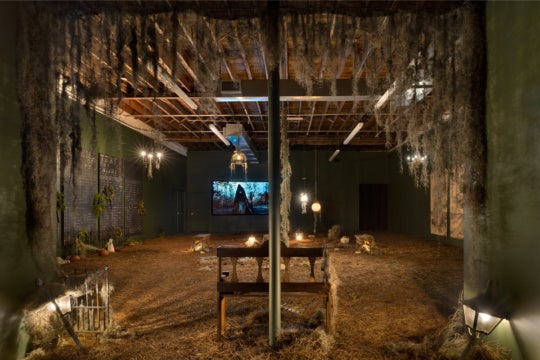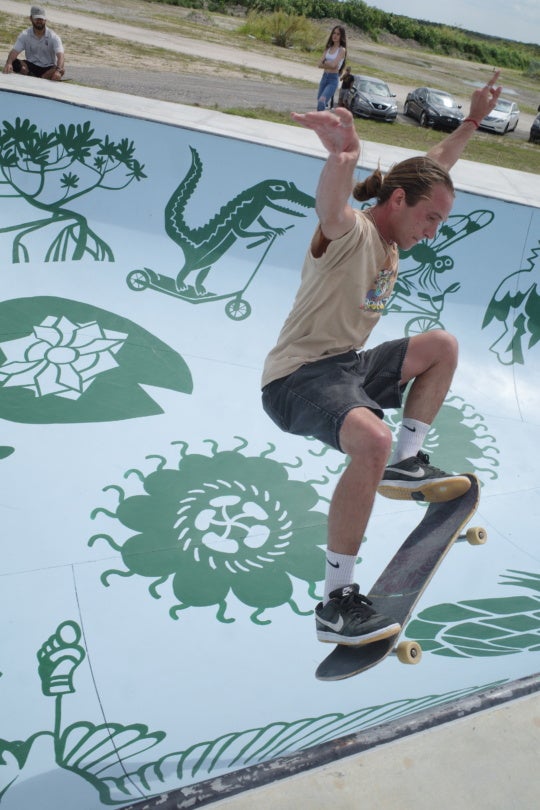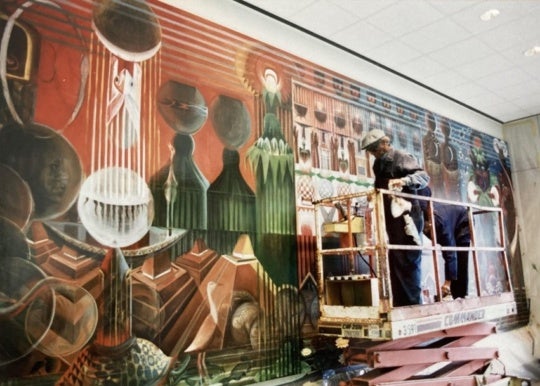If you appreciate the work we do to champion local art in Atlanta and the Southeast, please consider donating today. Your dollars ($) will count double ($$!) during BURNAWAY’s $15K Challenge matching grant from Possible Futures. Contributions of any amount are greatly appreciated. Your donations help us to continue to provide BURNAWAY as a free resource! You can make a donation here.
Helen Hale is a dancer and choreographer who recently received an Idea Capital grant to aid the development of her original one-woman dance theater production Sanity Ceremonies. She will be working in collaboration with costume designer Amanda Baumgardner, video artist Mike Boutté, set designer Elwen Hau, lighting designer and technical director Danny Davis, and sound/music technician Santiago Páramo.
Deidra Tyree Smith: What role does your everyday life play in this piece?
Helen Hale: The piece for me is about how we orient ourselves and how we navigate through choppy waters. The world is a hectic and baffling place, and I have a hypothesis that people perform small actions day after day to put one foot in front of the other. A good example would be my morning tea, which I could fix in my sleep. This and other “ceremonies” are rote, and [they] function to assemble my psyche [and let me] move forward with my day as gracefully as possible. So, in order to talk about that I’m using the mode of dance theater. I’m drawing from the material of my own life because it’s the only logical thing for me to do.
DTS: How does your ancestral lineage come into play within Sanity Ceremonies?
HH: In this piece, there’s a very clear referencing to my ancestral lineage on my mother’s side, particularly her Greek side. I have always had a love affair with my Greek heritage, and that strand has played a great deal into the process of assembling my identity. Within our American hodgepodge, I feel that this lineage has given me something distinct, a singular voice that has pierced some sort of collective sound. It’s always been very mysterious and beautiful to me, and I have decided to directly address this inheritance.
DTS: So, tell me more about Sanity Ceremonies. How have you created the movement within the choreography to resemble everyday actions, other than [through] modern dance technique?
HH: I’m looking at the daily grind and how we cope, but what I’m interested in is how we live. What does it look like to live how we want, or to love how we wish, or be brave when we need to be? What are the micro-aspects that we can … puzzle at? How do we posture ourselves in this existential storm, which we cannot control? This piece is a narrative that makes use of dance, text, costuming, props, lighting, film, animation, and sound to weave together the layers of our lives.
DTS: You’ve mentioned that Sanity Ceremonies is based on your life experience, and that you’re using all these different mediums to tell the story. What other elements have inspired you in the making of this piece?
HH: I have been thinking about the solo form and the idea of solo performance, which in my mind is closely related to storytelling. I’ve also been considering musical structure and rhythm. I’ve been reading poetry, thinking about word and meaning, and the relationships that a writer builds. Poets are geniuses because they give you vocabulary, and they set it up for you in a given way. It blows my mind how different deliveries from different angles, tiny tweaks, or the reverse of just one word can completely shift the meaning of what we experience.

DTS: What is the vocabulary, or [what are] other forms of movement technique, that [add] to the language and to the style of Sanity Ceremonies?
HH: Stylistically, I am influenced by an array of things. My experience with martial arts gives me an Eastern way of using the body and energy. I’m also drawing from the vocabulary of Greek folk dance and fusing that in some new ways. My study of release technique, improvisational technique, [José] Limón, [Martha] Graham, ballet, and African dance also add to the mix. So, there are a lot of ingredients in my physical memory. There are sections that are meditative or more phonetic, and some fuse in more or less obvious ways. For example, a section in the Sanity Ceremonies analyzes my “showy” dance. To translate this idea, I’m drawing from ballet and wind-up toys. In wanting to figure out how I need to morph my body to make that possible, I explore an organic inside-out process, or some visual specific.
DTS: I think this work is a metaphor for finding your own individual technique and style, and not comparing yourself to others. Basically, about a personal journey. What brought you to make the decision to create and perform a one-woman show? And what was your process in creating the piece?
HH: The idea was born from a Dance Truck performance in Auburn, Alabama, where they asked me to come do a solo piece. Once it was done, I thought I wouldn’t revisit it, but the concept stuck with me and began to grow. The other aspect is that if I’m asking other professionals to work with me, I want to be able to compensate them. Because of reality and my commitment to fair labor practices, I can’t pay a cast of people. Therefore, I can use myself and push to create different vocabularies, and to embody different characters and different modes for myself within one performance. It’s a challenge to mindfully create different sections within in the course of a single statement or narrative. In addition to my Greek and folk influences, I draw on the power of archetype and how it operates within the collective imagination. Included are those moments inspired by people like Isadora Duncan out on the hillside with her scarfs, just dancing with [abandon], and allowing her body to do what it wants to do.
Dance Jargon 101
to spot/spotting: the process of delaying the rotation of the head while staying relative to the body’s rotational speed, using a visual focus on one or more fixed points in space.





